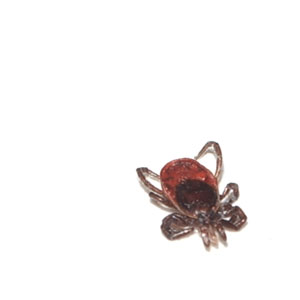How to Keep Ticks Out of Your Yard
By Chris Williams on April 24, 2013.
 It’s not too early to start thinking about tick prevention. In fact, blacklegged tick adults have been active all winter, feeding on deer. The blacklegged tick (formerly known as the deer tick) is the most important tick in our region since it transmits Lyme disease, as well as the diseases anaplasmosis and babesiosis. Overwintering tick nymphs become active in April, peaking in mid-summer.
It’s not too early to start thinking about tick prevention. In fact, blacklegged tick adults have been active all winter, feeding on deer. The blacklegged tick (formerly known as the deer tick) is the most important tick in our region since it transmits Lyme disease, as well as the diseases anaplasmosis and babesiosis. Overwintering tick nymphs become active in April, peaking in mid-summer.
You may know that ticks (and tick diseases) are more of a concern in yards that border on wooded areas. Ticks really like that in-between zone, between grass and woods. The greatest number of ticks will be located within 3 yards of the lawn’s edge, often on brush and tall grass where they wait until a potential host passes by.
There are several components of a tick management program for your yard including personal protection (use of repellents and tick checks), pesticide treatment of tick areas, and nonchemical controls that change your yard and the tick’s environment enough to make it less desirable for ticks.
Steps You Can Take to Prevent Ticks in Your Yard
- Keep grass mowed. Remove leaf litter, brush and weeds at the edge of your lawn, and around stonewalls and wood piles.
- Trim tree branches and shrubs at the wood edge of your lawn to let in more air and sunlight.
- Restrict the use of groundcovers, like pachysandra, in areas frequented by your family and pets. Landscape with xeric or less water-demanding plants whenever possible.
- Use plantings that do not attract deer and take steps to keep deer out of your yard such as the use of deer fencing.
- Take steps to reduce the number of rodents (including chipmunks) nesting in your yard by cleaning up nest sites, picking up fallen bird seed, and sealing openings in stone walls. [Deer mice and other rodents serve as hosts for ticks.]
- Create a 3-foot wide or wider wood chip, mulch, or gravel border between your lawn and the woods or any stonewalls. Widen any woodland trails so people and pets don’t brush against vegetation next to the paths.
- Use more hardscaping in your yard and less plantings. Install pathways of mulch, gravel, or tile near your house and in areas of frequent travel.
- Move children’s swing sets and sand boxes well away from the woodland edge and place them on a wood chip or mulch type foundation.
- Keep your pets out of the woods and away from heavy brush to reduce the number of ticks brought into your home.
Photo credit: megankhines / Foter.com / CC BY-NC-SA